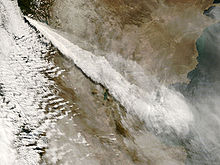
Back رماد بركاني Arabic Vulkan külü AZ Вулканічны попел BE Вулканична пепел Bulgarian আগ্নেয়ভস্ম Bengali/Bangla Cendra volcànica Catalan ТӀапломан чим CE Sopečný popel Czech Vulkansk aske Danish Vulkanische Asche German




Volcanic ash consists of fragments of rock, mineral crystals, and volcanic glass, produced during volcanic eruptions and measuring less than 2 mm (0.079 inches) in diameter.[1] The term volcanic ash is also often loosely used to refer to all explosive eruption products (correctly referred to as tephra), including particles larger than 2 mm. Volcanic ash is formed during explosive volcanic eruptions when dissolved gases in magma expand and escape violently into the atmosphere. The force of the gases shatters the magma and propels it into the atmosphere where it solidifies into fragments of volcanic rock and glass. Ash is also produced when magma comes into contact with water during phreatomagmatic eruptions, causing the water to explosively flash to steam leading to shattering of magma. Once in the air, ash is transported by wind up to thousands of kilometres away.
Due to its wide dispersal, ash can have a number of impacts on society, including animal and human health, disruption to aviation, disruption to critical infrastructure (e.g., electric power supply systems, telecommunications, water and waste-water networks, transportation), primary industries (e.g., agriculture), buildings and structures.
- ^ Rose, W.I.; Durant, A.J. (2009). "Fine ash content of explosive eruptions". Journal of Volcanology and Geothermal Research. 186 (1–2): 32–39. Bibcode:2009JVGR..186...32R. doi:10.1016/j.jvolgeores.2009.01.010.